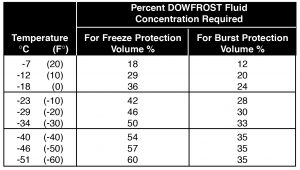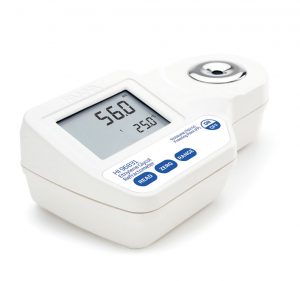
How to match glycol levels to various HVAC systems
August 24, 2016 | By Rob Waters
Glycol is a mystery fluid to many in the HVAC industry, but it is an essential tool for designing many different types of HVAC systems. In Canada, where glycol is essential to protect HVAC systems from freezing, most contractors have a basic understanding of why glycol is used. However, many may not realize all of the implications and issues that must be considered when the decision is made to use glycol in a system.
Glycol in a hydronic system impacts the way that many circuit components such as pumps, pipes, air eliminators and boilers work. If the wrong choices are made there can be serious consequences to the efficiency, performance and longevity of the system. Glycol must be accounted for early in the system design, as using glycol with its lower heat transfer capability will impact the sizing of many of the system’s components.
USING THE RIGHT GLYCOL
Water is a better heat transfer media than glycol–you can see that when you compare the specific heat of the fluids. At 60F/15.5C water has a specific heat of 1.0 Btu/(lb*oF). Compare this to 50 per cent glycol at 0.84 Btu/(lb*oF) and you can see that glycol has 16 per cent less heat carrying capacity. The specific heat also changes with temperature and it only gets worse for glycol at lower temperatures.
Glycol is also thicker and more viscous than water, making it more difficult to push through the pipes. If the system is originally designed for water, and then at the last minute changed over to glycol, you will most likely have problems as the initial sizing of components are no longer sufficient for the glycol system.
Related: What are the keys to optimal radiant system performance?
Using the correct type and concentration of glycol is very important, as you only want to use as much as required to do the job. Too much glycol adds expense, impedes heat transfer, and affects pumping capacity. Not enough glycol can lead to damaging and expensive freeze-ups.
The type and concentration of glycol used is dependent on the project location and the type and specific requirements of the system. There are two basic types of glycols used in HVAC systems, propylene glycol and ethylene glycol.
Both of these fluids have similar freeze protection and heat transfer characteristics with the main difference being that propylene glycol has a lower toxicity level. Due to its lower toxicity, propylene glycol is more commonly used in residential and small commercial HVAC systems.

Figure 1 The percentage of glycol required to provide a certain level of protection against freezing or burst protection.
Courtesy Dow Chemical, DOWFROST is a trademark of The Dow Chemical Company
Either type of glycol will always include added corrosion inhibitors to protect pipes and components. There are many different types of inhibitors used that are specific to different applications. Using the correct type of glycol – inhibitor mix is crucial to providing long-term reliable system operation. Climatic conditions are very different in Toronto and Yellowknife, so the levels of freeze protection required and the resulting concentration of glycol will vary for the same type of system installed in different locations.
All glycol manufacturers provide charts (see Figure 1), which show the percentage of glycol required to provide a certain level of protection against freezing or burst protection. Typically a 50 per cent concentration of glycol will give you freeze protection down to -30F/-34C. However to provide pipe burst protection to the same temperatures, only 33 per cent glycol is required. Burst protection means that the fluid can no longer be pumped, but it has not expanded to a point where it will burst pipes.
HVAC APPLICATIONS
The HVAC applications that most commonly use glycol are snow and ice melting systems, ground source heat pumps, solar water heating systems, chilled water cooling systems, and in the hydronic systems that require pipe burst protection due to their location or activity level. Some of these applications require high levels of freeze protection, while others only need a lower level of burst protection as a safety measure.
Snowmelt systems by their nature require a high level of freeze protection because all the components are located outside the building envelope and are exposed to the ambient conditions. This means that snowmelt systems require quite high levels of glycol concentration in the range of 50 to 60 per cent.
Solar water heating systems also require a very high level of freeze protection as solar collectors and piping are located outside the building. Typically glycol concentration in the range of 45 to 60 per cent will be required, with most applications in Canada using 50 per cent glycol. Installations in the far north usually need to increase the concentration to account for colder winters.
Solar systems also have the unique characteristic of producing very high fluid temperatures during summer stagnation conditions. This leads to very specialized glycol requirements that use special high temperature corrosion inhibitors to protect the fluid from breaking down rapidly. If the wrong glycol is used in a solar water heating system, the fluid can break down and turn nasty very rapidly. This can result in plugged collectors, blocked pumps, and in extreme situations systems that must be abandoned entirely. There are special glycols made exclusively for solar water heating systems and they are highly recommended for these types of systems.
Ground source heat pumps often use glycol in their earth loops. As these loops are often much deeper in the ground, they are typically not exposed to the same kind of extreme conditions and therefore require a lower concentration of glycol, usually in the range 15 to 25 per cent. Fluid toxicity is certainly an important issue in the ground source industry so therefore propylene glycol is usually essential for these types of applications.
Many hydronic heating systems, especially those that incorporate radiant floor heating will utilize glycol to provide a level of safety against burst pipes and the resulting damages that can occur to the building and the system. In these applications a lower concentration of glycol in the range of 25 to 30 per cent is usually utilized just to provide peace of mind against bursting pipes during unoccupied periods. Commercial buildings that use radiant floor heating systems and that may be unoccupied for periods of time are certainly candidates for this protection. Pipes that burst in a concrete slab are a serious problem that can result in very expensive and disruptive repairs.
CONSIDERATIONS
When glycol is used in the system there are certain installation, service and maintenance factors that must be considered to maintain a long reliable lifespan of the fluid and the system components. Here are a few of the things to look out for:
- Boilers that use aluminum heat exchangers have special glycol requirements. Make sure you check with the boiler manufacturer and use the correct fluid for these boilers, or you will be in for big problems down the road.
- Before installation of the glycol into the system, a thorough cleaning of the entire system must be done. If this is not done properly there can be problems with sludge formation or pipe fouling after the glycol is added, leading to a reduced lifespan of the glycol and system. Any residual dirt, debris, flux, or residual pipe oil can interact with the glycol and cause problems. A commercial pipe-cleaning agent should be added to the piping and then thoroughly flushed out with freshwater to remove any traces of the cleaning agent. Ideally the system should be blown out with air to remove any residual water prior to adding glycol water mixture.
- Many glycol vendors will provide glycol that is already pre-mixed. This is the best way to add glycol as it guarantees the correct glycol concentration, and that the water used in the mixture is free of contaminants. If 100 per cent glycol is purchased then on-site mixing is required, and this can cause issues if not done properly. When mixing glycol on-site with water it is highly recommended that only distilled or de-ionized water be used. Fresh water directly out of the tap often contains calcium, magnesium, and chlorides and when these come in contact with the glycol inhibitors, they often create problems with sludge and fouling. Finally after mixing, check the concentration with a glycol refractometer to ensure the concentration is correct.
- Once the system is charged with glycol, proper air elimination is critical for glycol systems. Air that becomes trapped in a glycol water mixture is especially hard to separate. Air pockets or frothing can result when the system pump is activated, which often leads to many frustrations during and after the commissioning process. A good quality micro bubble air eliminator is highly recommended for any system containing glycol.
- Different brands or types of glycol should never be mixed, due to the different corrosion inhibitors used by different manufacturers. If topping up an existing system, only use the same brand that was originally installed.
- When the system is operational, periodic testing of the glycol must be done to ensure that it is still suitable for use and providing the correct level of freeze protection. It is not unusual for something to go wrong in a system such as a leak or system maintenance, and the system ends up getting topped up with freshwater. This will resulting in a diluted glycol concentration and a lack of freeze protection. Burst pipes or frozen solar collectors can often be the result of this problem. Typically an annual check-up will include verification of the glycol concentration with a refractometer, and a check of the glycol PH level using litmus test strips. Glycol that has gone bad typically will have a low PH level, which if left unchecked, will start to corrode the metal components in the system. Usually when the PH level is too low the glycol must be drained, the system flushed and recharged with new glycol.
- Ultimately glycol must be disposed of when its life in the HVAC system is over. There are chemical supply companies that offer glycol disposal services, and this may be required depending on the type and quantity of glycol being used, and the regulations in your local area. Just pouring it down the drain may not be acceptable, and could land you in hot water with the environmental regulators in your area.Using glycol is an essential part of installing HVAC systems in Canada and if installed and maintained correctly will provide years of trouble free service. Be aware of all the issues and rely upon glycol professionals if you need to learn more about using glycol. Do not let glycol be a mystery fluid in any of your HVAC installations.
Robert Waters is president of Solar Water Services Inc., which provides training, education and support services to the hydronic industry. He is a mechanical engineering technologist graduate of Humber College and has over 30 years experience in the hydronic and solar water heating industry.





